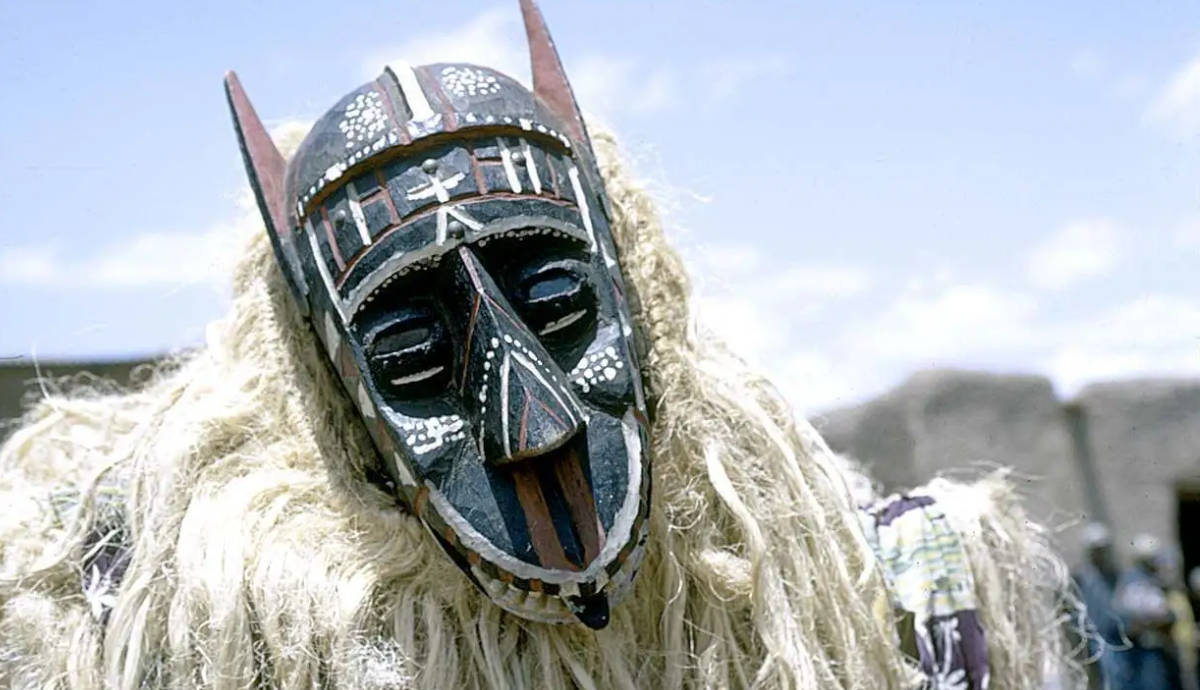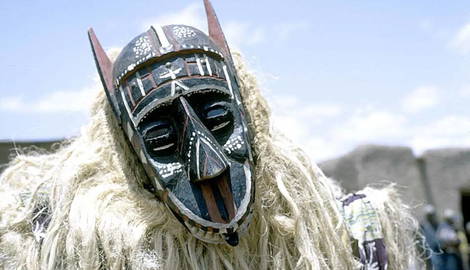
African tribal masks are a popular item among collectors and have been so since 19th century colonial forays into Africa. In Europe and North America, they adorn the walls of collectors and famous museums. However, in Africa they represent a living tradition that dates back thousands of years. Their manufacture and use follow special rituals that are linked to the spirit world. Read on to learn 10 fascinating facts about African masks.
1. Craftsmen Will Make Sacrifices For Protection

Carving and decorating African tribal masks is a tradition that is often passed down from generation to generation of craftsmen. Many tribal masks are carved from wood. Chopping down a tree to make a mask can be a dangerous activity and a chicken is often sacrificed to the tree before it is cut down. The craftsmen must also appease to the god of iron. He makes an offering of cock blood and other materials at a shrine he keeps near his workplace. He then uses an adze to carve and shape the mask. African adzes are collectibles in their own right.
2. Masks Often Incorporate Natural Materials

This can include materials derived from animals such as cowrie shells, feathers and ivory as well as animal skins, bones and horns. Sometimes they can be even more unusual, like porcupine quills.
Plant materials like raffia or cotton appear in some masks. Masks are even sometimes made with human teeth and hair. Decorative materials like metal, beads, terracotta and glazed pottery are sometimes found as part of masks.
When coloring a mask, the craftsman uses natural dyes made from leaves, tree bark, clay and seeds.
3. Mask Wearing Is A Vital Part Of African Secret Societies And Life Cycle Rituals

Africa has a number of secret societies that have a lot of influence in the communities where they are prevalent. These are usually divided into ones for men and women. They often initiate their members during puberty with circumcision rituals and often teach their members proper social manners and sexual comportment. Other secret societies are mainly comprised of politicians and law enforcement officers. Some play an important religious role in their community.

African tribal masks play an important role in life cycle rituals. These include circumcisions, weddings, funerals and the harvest season.
4. Wearing A Masks Erases Your Previous Identity

African tribal masks do not represent real people, dead or alive, or even animals, when they take on the form of animals. Moreover, when an individual wears and African mask, they no longer possess their own personality. Instead, a spirit occupies the mask and whatever the wearer does or says is attributed to the spirit of the mask. These spirits are often dead ancestors or even the spirits of individuals not yet born.

In some cases, the mask and other accouterments cover the entire body so the individual cannot be identified by others. No one mentions the name of the wearer. In fact, if a mask falls off in front of someone who is not a member of the secret society, the spirit of the mask can become angry and seek revenge.
5. Masquerades Are A Form Of Peer Pressure

Masks are normally worn during dance ceremonies. In some communities, all members of society are required to attend these events. The dancers wearing the masks approach members of the audience and proceed to tell them what their bad habits and moral failings were. Being shamed and called out like this in such a public manner usually led them to change their behavior from there on out.
Malawi’s first president Kamuzu Banda used such masquerades to keep his detractors in line. Toward the end of his dictatorship, his political opponents turned the tables on him by holding masquerades lampooning him and his family.
6. The Ancient Egyptians Made Masks
The climate and geography of sub-Saharan Africa means that the oldest surviving masks are only a couple hundred years old as they are not preserved in archaeological records. Their history on the continent certainly goes back much further than that.

The first indication that Africans used masks is a rock painting from Algeria. The earliest known surviving masks come from graves at the Egyptian predynastic site of Hierakonpolis. Of course, perhaps the most famous mask in the world is the solid gold funerary mask of Tutankhamun. The Egyptians also buried lesser known individuals wearing funerary masks of lower craftmanship. They often fashioned these masks out of cartonnage, a material similar to papier maché.

The ancient Egyptians used masks in rituals in similar ways to modern Africans. Two masks survive depicting the jackal headed god Anubis. Priests would have worn these during funerary rituals. A man wearing a mask of the god Bes oversaw puberty rituals.
7. Some Early 20th Century Artists Were Inspired By And Collected African Tribal Masks

Pablo Picasso was enthralled by the African tribal masks he saw at the Musée d’Ethnographie du Trocadéro in Paris when he visited in 1907. He began collecting African masks himself and they served as inspiration for some of his paintings over the next few years. Among these are Les Demoiselles d’Avignon, Head of a Sleeping Woman (Study for Nude with Drapery), and Femme nue.
Picasso was hardly alone in his passion for African masks. The list of artists who collected African masks reads like a who’s who of the heavyweights of the art world in the early 20th century. They include Paul Klee, Henri Matisse, Man Ray, Jackson Pollock, and Edvard Munch.
8. French President Macron Wants African Masks Removed From French Museums

Most African tribal masks in public and private collections were obtained during the colonial period. In 2017, French president Emmanuel Macron commissioned a report from French art historian Bénédicte Savoy and Senegalese economist Felwine Sarr about African art in public collections in France. The report estimated 90% of African art is outside Africa, whereas most African national museums have collections under 3000 pieces. Countries like Senegal and Benin are building new museums and lack artwork. The authors of the report recommended that this art should be repatriated to its countries of origin to make up for the injustices of French colonialism.
As a result, Macron has already ordered the return of art but only one piece returned to date. Resistance has been fierce in the art and museum world to the recommendations in the report. The director of the French museum with the largest collection of African art objected to its findings. Stéphane Martin, director of the Musée du Quai Branly-Jacques Chirac stated that it tainted, “everything that was collected and bought during the colonial period with the impurity of the colonial crime.”
9. A Congolese Businessman Is Also Using Vigilante Methods To Return Masks To Africa

Sindika Dokola is one of Africa’s richest men and an avid art collector with over 5000 pieces in his private collection. He is also a strong proponent for the repatriation of African art. He has taken an almost vigilante approach towards museums, auction houses and private collectors to achieve his objectives. If he believes an object is looted or questions its pedigree, he approaches the owner and demands evidence of what was paid and where it was acquired. He then makes an offer to buy the object outright, at cost, or face legal action.
Fortunately for Dokola, several objects made their journey back to Africa. But, for all his rhetoric about African art belonging in Africa, ironically, he has displayed objects from his own collection in Portugal. As of January 2020, the Angola authorities seized his collection as part of a corruption case against his wife, the richest woman in Africa and daughter of the former Angolan president.
10. Be Wary! African Masks These Days Often Have A “Made In China” Sticker

While traditionally masks were sacred objects, nowadays many are commercial reproductions made in China or modern forgeries fabricated in African workshops. All of these imitations on the market require collectors to be wary. It is always recommended to consult with a museum curator, art dealer or gallery.









